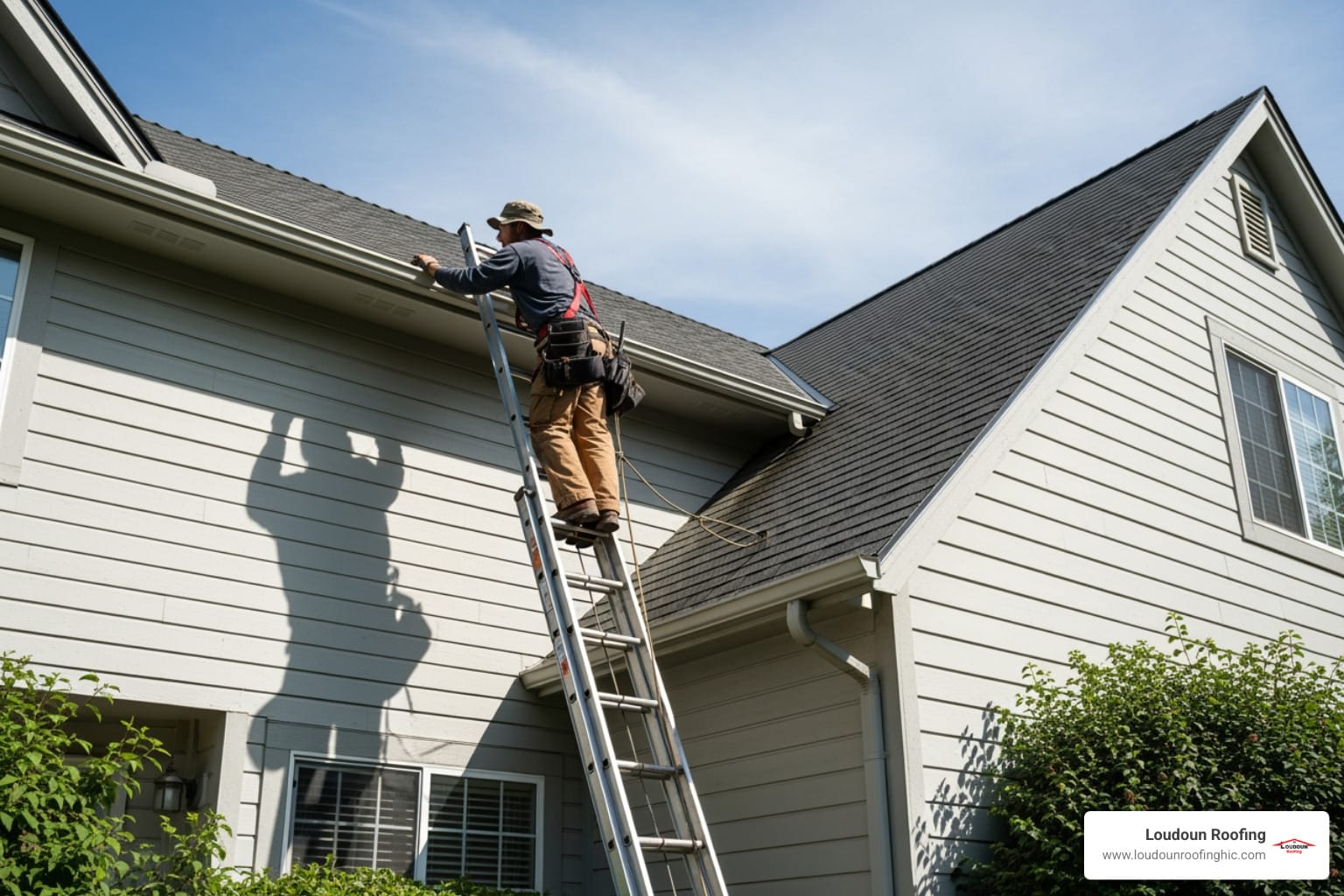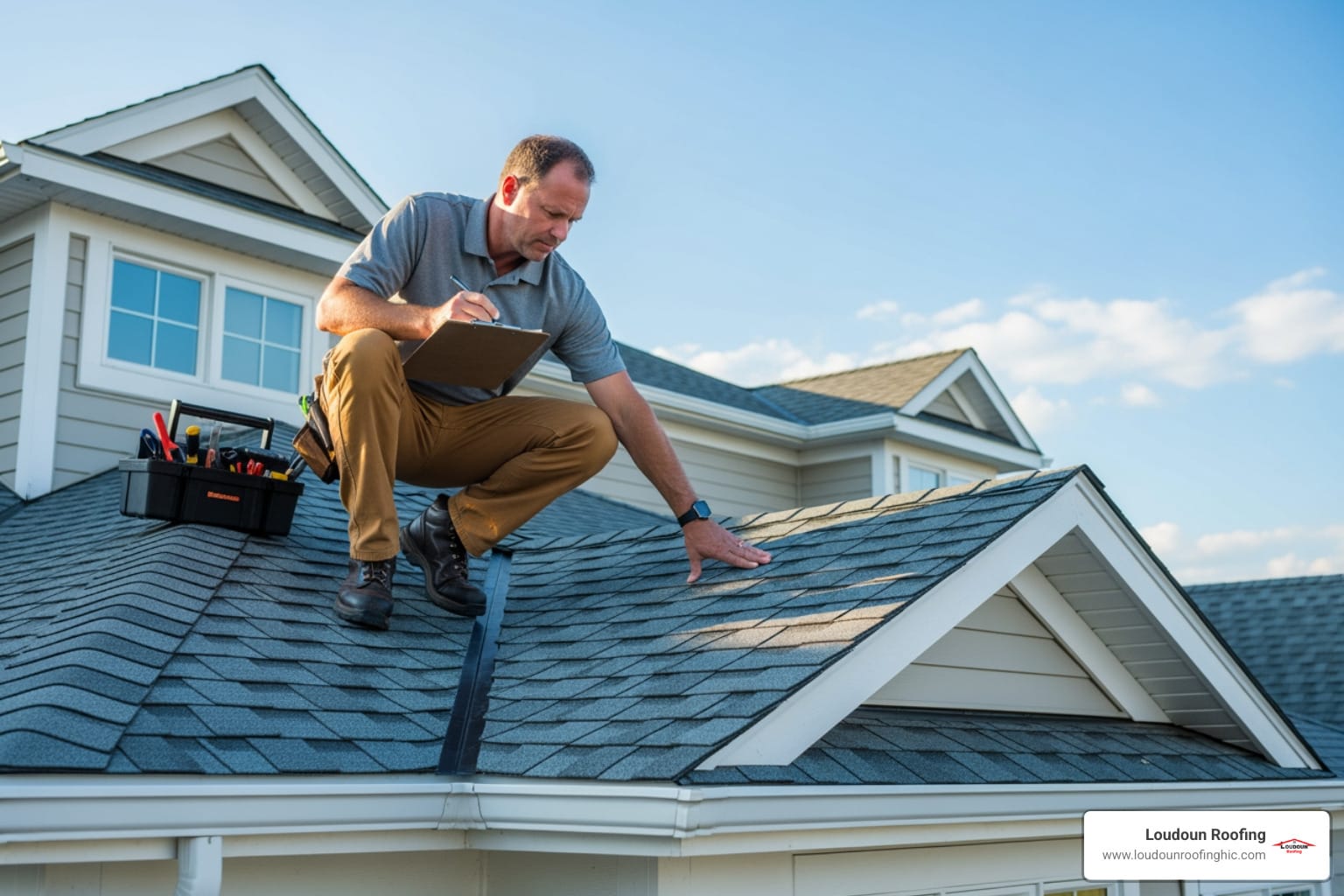Why Commercial Flat Roof Problems Can’t Wait
Commercial flat roof repair becomes critical when minor issues threaten your entire business operation. Unlike residential sloped roofs that naturally shed water, flat roofs face unique challenges—from ponding water to membrane deterioration—that can quickly escalate into major structural problems. Protecting your property requires a team that understands these complexities, offering expert commercial roofing solutions to prevent minor issues from turning into costly disasters.
Quick Solutions for Common Commercial Flat Roof Issues:
- Ponding Water – Install additional drains or tapered insulation
- Membrane Cracks – Apply compatible patches with reinforcing fabric
- Seam Separation – Re-seal with appropriate adhesives or heat welding
- Flashing Damage – Replace or repair around penetrations and edges
- Blistering/Bubbling – Cut out damaged sections and install new membrane
- Clogged Drains – Clear debris and inspect drainage systems
The global commercial flat roofing market is projected to reach $16.8 billion by 2030, driven by the durability and cost-effectiveness of modern systems like TPO, EPDM, and PVC membranes. However, even the best materials require professional attention when problems arise.
Time is money when it comes to commercial roofing. What starts as a small leak can shut down operations, damage inventory, and create liability issues. Professional inspections should happen at least twice yearly, with additional checks after severe weather events.
As Frank Lloyd Wright once said when informed of a leaking flat roof he designed, he suggested the occupant “move to another part of the room.” Today’s building owners need better solutions than moving around puddles.
We at Loudoun Roofing & Home Improvement specialize in commercial flat roof repair throughout Northern Virginia, handling everything from emergency leak repairs to complete system restorations. Our hands-on approach ensures every project meets the highest standards while minimizing disruption to your business operations.
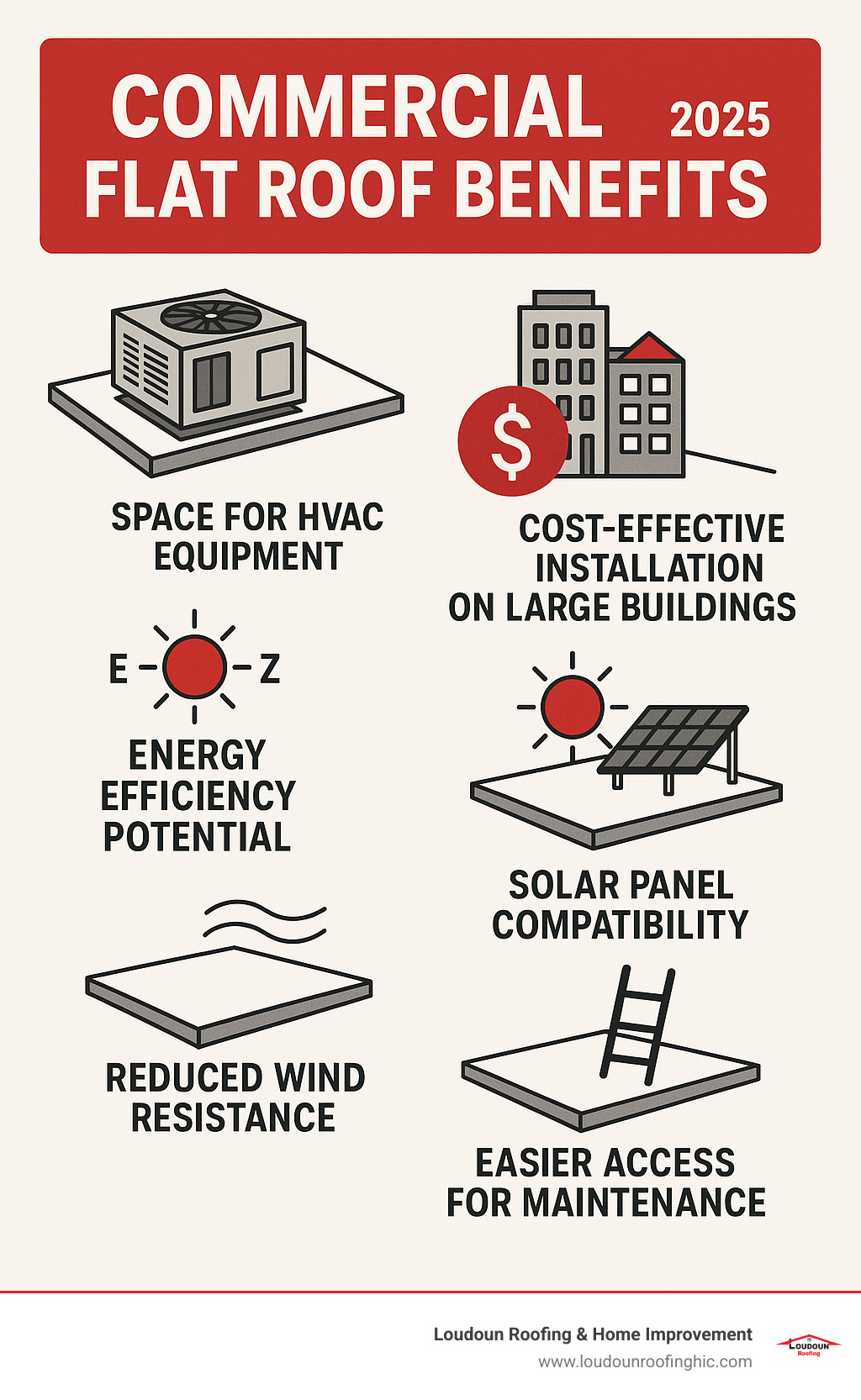
Identifying the Red Flags: When Does Your Flat Roof Need Repair?
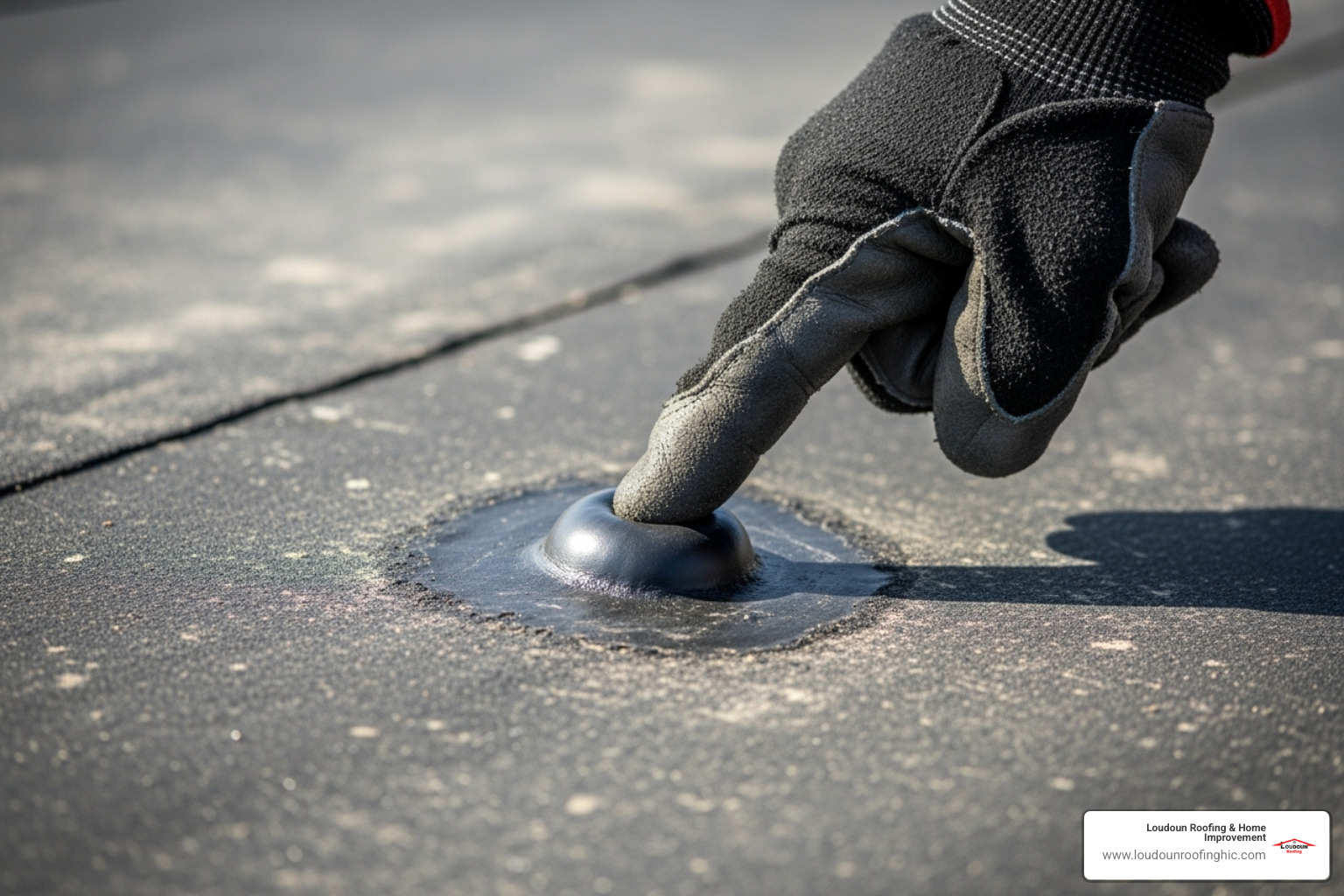
Your commercial flat roof works hard every day, silently protecting your business from whatever Mother Nature throws its way. But like any hardworking system, it eventually shows signs of wear and tear. The key is catching these warning signs early, before a minor issue becomes a major headache that shuts down your operations.
Ponding water is often the first red flag most building owners notice. While your flat roof should have a slight slope for drainage, water that sits for more than 48 hours spells trouble. This standing water doesn’t just look bad – it adds serious weight to your roof structure and accelerates membrane breakdown. When you see puddles that won’t go away, it’s time to call in the professionals for commercial flat roof repair.
Visible blistering or bubbling across your roof membrane tells a story of trapped air or moisture underneath. These raised areas might seem harmless, but they’re actually weak spots where the membrane has lost its grip. Left alone, these blisters will eventually crack open, creating direct pathways for water to enter your building.
The membrane itself might develop cracks and tears from foot traffic, falling branches, or extreme temperature swings. These openings are like leaving your front door wide open during a rainstorm – water will find its way in. Similarly, seam separation creates vulnerable entry points where different sections of your roof membrane should be tightly joined together.
Don’t overlook your flashing – the unsung hero that seals your roof around vents, pipes, and HVAC units. When flashing becomes damaged, loose, or improperly sealed, it’s often the culprit behind mysterious leaks. We’ve seen countless cases where building owners spent time and money looking for complex problems, only to find simple flashing issues were to blame.
Clogged drains might seem like a minor maintenance issue, but they’re actually leak disasters waiting to happen. When leaves, debris, or even gravel block your drainage system, water has nowhere to go except into places it shouldn’t be.
Inside your building, interior water stains on ceilings or walls are your roof’s way of waving a white flag. These stains are definitive proof that water is getting through, though the actual leak might be far from where you see the damage. Increased energy bills can also signal roof problems, especially when damaged insulation loses its ability to keep your building comfortable.
If you’ve recently weathered a severe storm, don’t assume your roof escaped unscathed. Hail, high winds, and heavy snow can cause damage that isn’t immediately visible but will cause problems down the road. For a comprehensive look at storm-related roof damage, check out our detailed guide on storm and hail damage.
Common Types of Commercial Flat Roofs
Understanding your roof system helps you make informed decisions about repairs and maintenance. Each type has its own personality, strengths, and repair considerations.
Built-Up Roofing (BUR) systems are the veterans of the flat roofing world. These “tar and gravel” roofs have protected commercial buildings for over a century, using multiple layers of asphalt and reinforcing fabrics topped with gravel. They’re incredibly durable and fire-resistant, capable of lasting up to 40 years with proper care. However, they’re heavy, messy to install, and finding leaks can feel like searching for a needle in a haystack.
Modified Bitumen takes traditional asphalt and gives it a modern upgrade with polymer modifications. This creates a more flexible, durable system that handles temperature extremes better than its predecessors. Installation is cleaner than BUR, and repairs are typically straightforward. These systems commonly last 20-30 years, though torch-applied versions require careful safety protocols during installation.
EPDM (rubber) roofing has earned its reputation as a reliable workhorse. This synthetic rubber membrane offers excellent weather resistance and flexibility, handling everything from scorching summers to freezing winters. EPDM roofs can protect your building for 25-35 years or even longer with proper maintenance. The main considerations are puncture resistance and ensuring seam adhesives remain strong over time.
TPO (Thermoplastic Olefin) has become increasingly popular, and for good reason. Its white or light-colored surface reflects solar heat, keeping your building cooler and energy bills lower. The heat-welded seams create strong, permanent bonds that outperform glued connections. Most TPO systems provide 20-30 years of reliable service, though quality can vary between manufacturers.
PVC roofing represents the premium end of single-ply membranes. It offers superior chemical resistance, making it ideal for restaurants or industrial buildings where grease or chemicals might contact the roof. PVC’s fire resistance and strong heat-welded seams contribute to its reputation for lasting 30 years or more. The higher upfront cost often pays for itself through longevity and performance.
The Impact of Weather on Your Roof
Northern Virginia’s weather keeps us on our toes, and your commercial flat roof feels every bit of it. UV degradation happens slowly but relentlessly, as constant sun exposure breaks down roofing materials, making them brittle and prone to cracking. This is especially tough on darker membranes that absorb more heat.
Hail impact damage can range from obvious punctures to subtle weakening that causes problems months later. Even small hailstones can compromise membrane integrity, creating future leak points. Wind uplift tests your roof’s attachment system, potentially lifting edges and seams if the membrane isn’t properly secured.
Snow load stress adds significant weight to your roof structure while creating drainage challenges when it melts. Freeze-thaw cycles are particularly destructive, as water expands when it freezes and contracts when it thaws. This repeated expansion and contraction can turn small cracks into major problems and dislodge flashing around roof penetrations.
Understanding these weather impacts helps explain why regular inspections and prompt commercial flat roof repair are so important for protecting your investment.
The Professional Commercial Flat Roof Repair Process

When your commercial flat roof shows signs of trouble, the smartest move is calling in the professionals. At Loudoun Roofing & Home Improvement, we’ve developed a systematic approach to commercial flat roof repair that ensures lasting results and minimal disruption to your business operations.
The repair process begins with a professional inspection conducted by our HAAG-certified inspectors. We don’t just look at the obvious problem areas – we examine your entire roof system to understand what’s really happening. Sometimes a leak in one area actually originates from damage somewhere completely different. Our inspectors might even perform core sampling to check the condition of underlying layers and insulation.
Once we complete our assessment, we provide a detailed damage assessment report. This isn’t just a quick estimate scribbled on the back of a business card. We explain exactly what’s wrong, why it happened, and what needs to be done to fix it properly. This thorough evaluation helps us create a repair plan that addresses the root cause, not just the symptoms.
Material selection comes next, and this is where our expertise really matters. Using incompatible materials is like trying to patch a tire with duct tape – it might work temporarily, but it won’t last. We match repair materials to your existing roof system, whether that’s EPDM, TPO, modified bitumen, or built-up roofing.
Before any work begins, our team handles site preparation and implements strict safety protocols. We set up proper access routes, establish safety barriers, and ensure our crews have everything they need to work efficiently and safely. Safety isn’t negotiable – our teams are fully bonded, carry comprehensive insurance, and follow industry-standard safety procedures.
The final step involves thorough debris removal and a comprehensive final inspection. We clean up completely and conduct a detailed walkthrough to ensure everything meets our standards. You can learn more about our comprehensive approach on our roof repair services page.
Key Steps in a Commercial Flat Roof Repair
The actual repair work follows a methodical process that ensures long-lasting results. We start by cleaning the damaged area thoroughly – any dirt, debris, or loose material can prevent proper adhesion of repair materials. It’s like trying to put a bandage on dirty skin; it simply won’t stick properly.
Next comes removing compromised material. We carefully cut away any sections of membrane that are damaged beyond repair, creating clean edges that will bond well with new materials. This might seem aggressive, but it’s better to remove questionable material now than deal with failure later.
Applying compatible patches or sealants requires precision and the right materials. For EPDM roofs, we use EPDM patches with specialized adhesives. TPO repairs get TPO patches that are heat-welded for a seamless bond. Modified bitumen systems receive asphalt-based repairs that chemically bond with the existing membrane.
When dealing with seam separation, we don’t just slap some sealant over the gap and call it good. We properly re-weld or re-adhere the seams, often adding reinforcing fabric for extra strength. These repairs should be invisible when we’re done.
Repairing or replacing flashing is often the most critical part of the job. Flashing around vents, HVAC units, and roof edges is where most leaks actually start. We ensure new flashing is properly secured and sealed, creating a watertight barrier that will last for years.
Finally, we make sure to address proper drainage issues. There’s no point fixing a leak if water is just going to pond in the same area again. We clear drains, check slopes, and make recommendations for preventing future water accumulation.
Common Materials Used for Commercial Flat Roof Repair
The success of any flat roof repair depends heavily on choosing the right materials for the job. Liquid-applied membranes have become increasingly popular because they create a seamless, self-flashing surface that’s perfect for complex roof geometries. These systems cure to form a durable, UV-resistant barrier that can extend your roof’s life significantly.
For traditional built-up and modified bitumen systems, asphalt-based cements provide excellent adhesion and waterproofing. These thick, viscous compounds fill cracks and bond strongly to existing surfaces, creating repairs that move with the roof through temperature changes.
EPDM and TPO patches are pre-manufactured pieces of membrane material that we cut to size and apply over damaged areas. The key is using patches made from the same material as your existing roof and applying them with the proper adhesives or heat-welding techniques.
High-quality sealants and caulks play a supporting role in most repairs, sealing around penetrations and filling small gaps. We use only commercial-grade products that remain flexible through temperature extremes and won’t crack or shrink over time.
Reinforcing fabric adds strength to liquid-applied repairs and helps bridge larger cracks or damaged areas. Think of it as adding rebar to concrete – it provides structural support that prevents the repair from failing under stress.
We stay current with industry best practices through resources like the National Roofing Contractors Association, ensuring our repair methods meet or exceed industry standards. Every material we use is chosen for compatibility with your existing roof system and Northern Virginia’s challenging climate conditions.
Prevention is Key: The Value of Proactive Maintenance
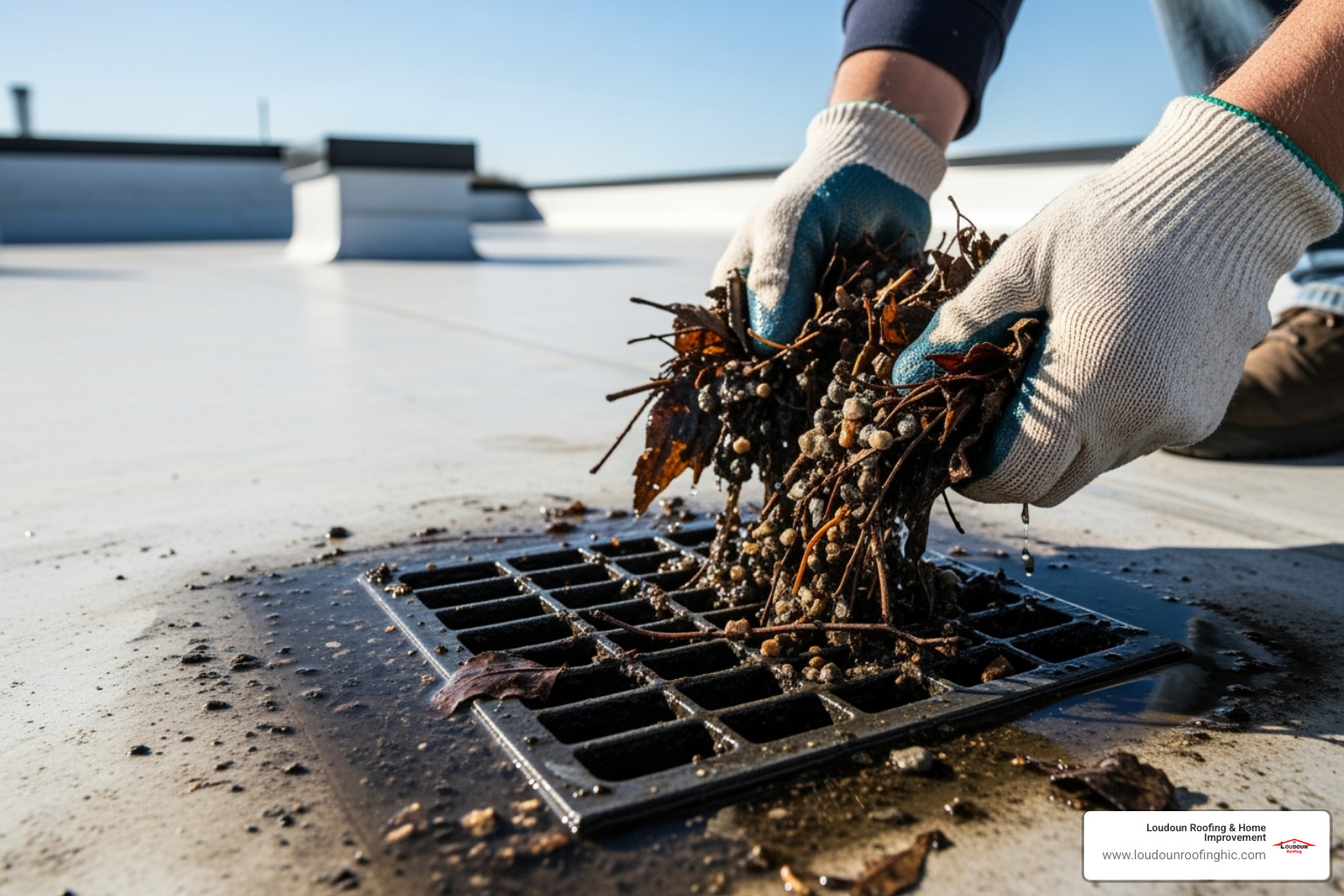
A commercial flat roof is a significant investment, and like any investment, it requires ongoing care to protect its value. Proactive maintenance is not just a recommendation; it’s a necessity for extending your roof’s lifespan and preventing costly emergencies.
Regular professional maintenance can help maximize a flat roof’s lifespan and protect your investment. We’ve seen how a little bit of proactive care goes a long way in saving businesses money and headaches.
Creating a Roof Maintenance Plan
Implementing a structured maintenance plan is the cornerstone of a healthy commercial flat roof. It allows us to catch potential issues early, often before they become visible problems inside your building.
- Maximizing Roof Lifespan: Regular inspections and timely minor repairs can significantly extend the life of your roof. TPO and PVC roofs typically last 20-30 years, while EPDM roofs can last 25-35 years with proper maintenance. Consistent care helps you reach and even exceed these estimates.
- Preventing Major Leaks: Small cracks or separated seams, if left unaddressed, will inevitably lead to major leaks. Maintenance identifies and fixes these vulnerabilities before they turn into water damage.
- Protecting Structural Integrity: Ponding water and persistent leaks can compromise the structural components of your building. Proactive maintenance mitigates these risks, protecting your entire property.
- Maintaining Property Value: A well-maintained roof contributes to the overall value and curb appeal of your commercial property. It signals to potential tenants or buyers that the building has been cared for.
- Avoiding Business Disruptions: A sudden roof leak can halt operations, damage inventory, and create an unsafe environment for employees and customers. Regular maintenance minimizes the risk of such disruptive emergencies.
- Upholding Warranty Requirements: Many manufacturer warranties for commercial roofing systems require regular professional inspections and maintenance to remain valid. Neglecting maintenance could void your warranty, leaving you responsible for costly repairs.
Creating a Roof Maintenance Plan
Our approach to roof maintenance is designed to be comprehensive and custom to your building’s specific needs.
- Scheduled Inspections (Twice-Yearly): We recommend professional inspections at least twice yearly, typically in the spring and fall. These routine checks allow us to identify minor wear, potential weak spots, and any issues caused by seasonal changes. Additional inspections should be conducted after severe storms or when you notice potential issues. Commercial buildings with high foot traffic or extensive HVAC equipment may require more frequent inspections.
- Debris and Drainage Clearing: Regular cleaning of your roof surface, drains, scuppers, and downspouts is vital. Even a small amount of debris can block a drain filter, leading to water backup and ponding. We proactively clear these to ensure proper water runoff.
- Minor Repairs and Sealing: During inspections, we address minor issues on the spot, such as small cracks, pinholes, or minor seam separations. We also check and re-seal flashing around penetrations and edges to maintain watertight integrity.
- Detailed Record-Keeping: We maintain meticulous records of all inspections, repairs, and maintenance activities. This provides a valuable history of your roof’s condition, helping us track its performance and plan for future needs.
To explore how our preventative maintenance programs can benefit your commercial property, contact us to learn more about our services.
Navigating the Costs: Repair, Replace, or Restore?
Making the right financial decision for your commercial flat roof repair can feel overwhelming, especially when you’re facing potential business disruptions. The truth is, there’s no one-size-fits-all answer – but understanding your options will help you make the smartest choice for your budget and timeline.
Several key factors influence the cost of any roofing project. Roof size is the most obvious – a 50,000 square foot warehouse will naturally cost more than a 5,000 square foot office building. The material type also plays a significant role, as TPO and EPDM repairs typically cost less than specialty systems like PVC or modified bitumen.
The extent of damage often determines whether repair is even feasible. A small puncture or isolated leak might cost a few hundred dollars to fix, while widespread membrane deterioration could require tens of thousands in restoration work. Accessibility matters too – if your building requires special equipment or safety measures to reach the roof, expect higher labor costs.
Labor costs vary based on the complexity of the work and local market rates. In Northern Virginia, skilled commercial roofing technicians command premium wages, but their expertise often saves money in the long run by getting the job done right the first time.
Here’s how the three main options typically compare:
Repair generally costs $3-8 per square foot and can extend your roof’s life by 2-5 years. This works best for localized damage affecting less than 25% of the roof surface. Restoration runs $4-12 per square foot and can add 10-15 years to your roof’s lifespan. It’s ideal when the underlying structure is sound but the membrane needs refreshing. Replacement costs $8-20 per square foot but gives you a completely new roof lasting 20-30+ years.
When to Replace Instead of Repair
Sometimes, continuing to patch a failing roof is like putting bandages on a broken leg – it might provide temporary relief, but it won’t solve the underlying problem.
Widespread damage covering more than 25-30% of your roof usually signals it’s time for replacement. At this point, the cost of multiple repairs often exceeds the investment in a new system. If your roof is nearing the end of its expected lifespan – say, a 25-year TPO roof that’s already 20 years old – replacement makes more financial sense than expensive repairs.
Persistent leaks despite previous repairs indicate systemic failure rather than isolated problems. When you’re calling for repairs multiple times per year, those costs add up quickly. Outdated, inefficient materials might also justify replacement, especially if energy costs are eating into your profits.
Multiple layers of existing roofing create additional challenges. Many building codes limit the number of roof layers, and excessive weight can stress your building’s structure. In these cases, a complete tear-off and replacement becomes necessary.
Understanding Warranties on Repairs
A good warranty protects your investment and gives you peace of mind. Most reputable contractors offer both workmanship warranties covering their installation quality and help you access manufacturer material warranties covering product defects.
Warranty duration typically ranges from 1-5 years for repairs, depending on the scope of work and materials used. Larger restoration projects often carry longer warranties than small patch jobs. Understanding exclusions and limitations is crucial – warranties typically don’t cover damage from extreme weather events, building movement, or lack of maintenance.
The importance of certified installers cannot be overstated. Many manufacturer warranties require installation by certified contractors to remain valid. At Loudoun Roofing & Home Improvement, our certifications ensure your warranty protection stays intact while delivering the quality workmanship your building deserves.


